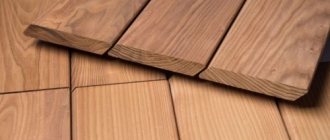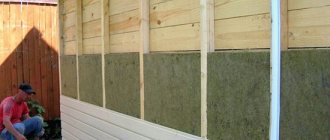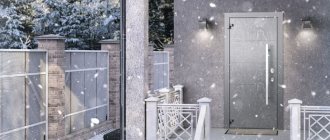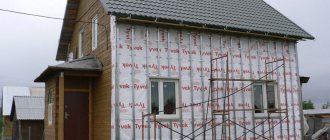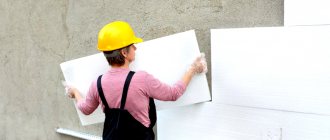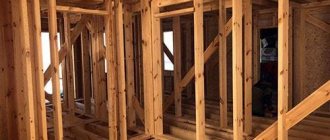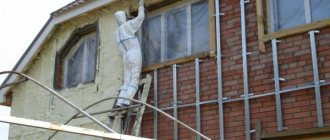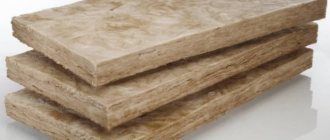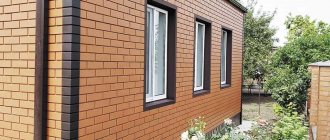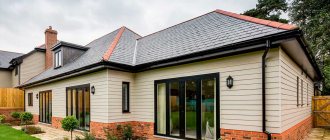The main quality of a good home is the ability to retain heat for a long time without loss, and therefore you should be especially careful when choosing insulation. The modern market of thermal insulation materials includes about 15 types of insulation. We have selected 9 of the most effective ones that are suitable for any structure
Read in the article:
- Mineral (stone) wool
- Extruded polystyrene foam
- Liquid foam
- Cork insulation
- Foam glass
- Ecowool
- Sawdust
- Straw
- Hemp and flax
1
Mineral (stone) wool
Rock wool is one of the most common and sought-after insulation materials on the market, and there are several reasons for this.
High heat saving ability
. The thermal conductivity of stone wool varies from 0.035 to 0.042 W/(m*K). In other words, a 10 cm thick layer of this material retains heat as well as 25 cm of timber or 117 cm of brickwork.
Fire safety.
Stone wool does not burn or smolder, because the melting point of basalt fibers exceeds 1000°C.
Vapor permeability.
Thanks to its relatively loose, “airy” structure, stone wool allows water vapor to pass through, which is formed in the house as a result of human activity (showering, cooking, washing, etc.). This means there is no need to worry about mold formation.
Sound absorption ability.
The same fibrous structure makes mineral wool a good sound insulator. So, when covering facades with stone wool, you can solve two problems at the same time: the house will become both warm and quiet.
Resistance to aggressive environments.
Mineral wool insulation is not afraid of mold, mildew and aggressive chemicals. And of course, “foamed stone” does not arouse food interest among insects and rodents.
Light weight.
A package of slabs with a total area of 0.35 m² weighs from 10 to 70 kg (depending on the thickness of the material). Thanks to its relatively low weight, both transportation and installation are facilitated.
Minor shrinkage.
Unlike many loose materials, stone wool almost does not lose volume over time. And that means heat-saving properties.
Durability
. The material retains its performance characteristics for 70-100 years.
Mineral wool in rolls
Mineral wool in slabs
How to calculate the thickness of insulation
If you look through SP23-101-2004 or a similar but later set of rules SP 50.13330.2012, you can see that calculating the thickness of the insulation is not so easy.
Each building is “individual”. When developing a project and approving it, such thermal calculations are made by specialists. And here a whole range of parameters are taken into account - the characteristics of the region (temperatures, length of the heating season, average number of sunny days), the type and area of glazing of the house, the thermal capacity of the floor covering, the thermal insulation of the roof and basement. Even the number of metal connections between the wall and the cladding matters.
But if the owner of a previously built house decides to insulate it (and the new standards introduced in 2003 are much stricter than the old ones), then he will have to choose between three parameters of the “standard thickness” of insulation - 50, 100 and 150 mm. And here the accuracy of calculations is not needed. There is a diagram that shows the equivalent dimensions of the thickness of different materials (in average form), the wall of which will meet the new requirements for thermal protection.
Only a house made of aerated concrete blocks with a thickness of 45 cm does not need insulation Source legkovmeste.ru
And then it’s simple. They take the thickness of a wall made of a certain material and see how much is missing from the standard. And then they calculate in proportion what thickness of the insulation layer of the outside wall of the house should be added. Taking into account that a wet façade also has a layer of plaster, and a ventilated façade has an air gap, plus the interior finishing of the façade walls, you can be sure of sufficient thermal protection.
And the issue of insulating the roof, floors and choosing good windows is decided separately.
It’s even easier to use one of the many online calculators. The figure here, of course, is approximate, but rounded up to the nearest standard insulation thickness, it will give the required result.
Flaws
High price.
Basalt wool is quite expensive. One cubic meter of material costs from 1,500 to 6,500 rubles. (depending on density and a number of other factors). Such a high price tag is primarily due to the complexity of production and the need to use expensive equipment, in particular blast furnaces.
Use of environmentally unsafe materials.
Stone wool consists of more than 95% of stone itself, but it cannot be called an absolutely natural product. To prevent the boards from falling apart into fibers, manufacturers are forced to use binders, in particular formaldehyde resins. Of course, self-respecting companies use them in minimal quantities, but there is always the possibility of “running into” a low-quality product that emits toxic fumes.
There is only one way to minimize risks - by checking the documents for the products. The laws of the Russian Federation require manufacturers of heat-insulating materials to obtain a Fire Safety Certificate, as well as an Expert Opinion on compliance with current sanitary standards and rules.
Types of stone wool
Basalt-based insulation is available in several modifications. Rolled fabric (the width of which is usually 1.2 m, and the length varies from 7 to 12 m), from most manufacturers has a low density - only 35 kg/m³. This material can only be used for horizontal laying in areas without any load. Such solutions do not occur very often.
The large area of the rolled fabric allows it to be laid with a minimum number of seams, and therefore cold bridges
The most popular is stone wool in the form of slabs (dimensions 0.6-1 m by 1.2 m and thickness from 30-200 mm). The main factor determining the scope of their application is density. Depending on this, the material is divided into several grades.
P-75
(density 75 kg/m³). Used for insulating surfaces with minimal load, for example, interior partitions and ceilings.
P-125
(125 kg/m³). Suitable for thermal insulation of floors, interfloor ceilings and facades.
PZh-175
(175 kg/m³). Designed for thermal insulation of reinforced concrete and metal walls and ceilings.
PPZh-200
(200 kg/m³). The material of maximum density is used for insulating roofs and floors under screed.
Selecting wall insulation by packaging type
The form of packaging of the material used to insulate the building also matters. For example, the product range of the leading mineral wool manufacturer ISOVER includes rolls and slabs. Each wall insulation has its own advantages and the choice of a specific material depends on the type of construction, the characteristics of the building and installation conditions.
Rolls
Wall insulation in the form of rolls provides ample opportunities for use during construction work. Long rolls of insulation can be cut to fit any pitch of the sheathing - the elastic material does not crumble or crumble. Rolls are convenient to roll out on horizontal surfaces, so this quartz-based mineral wool is often used to insulate roofing structures and facades of large buildings. Thermal insulation of walls using mineral wool in rolls promotes hermetic installation and is well suited for insulating joints. It covers the gaps without forming “cold bridges”.
Plates
Quartz-based mineral wool slabs are the simplest and most convenient option for insulating the walls of a house. In this case, the work is carried out using small heat-insulating boards, completely ready for installation. Mineral wool material slabs are made according to standard dimensions for lathing made of wooden beams with a pitch of 600 mm. The elastic material allows them to stand upright, eliminating gaps, and does not require additional fixation with fasteners during installation. Laying such slabs can be done alone.
What is the best way to insulate facades – from the inside or the outside?
There are three options for positioning the insulation relative to the wall.
The first one is from the inside.
This method has few advantages. This is ease of installation (working indoors is more comfortable than outdoors) and there is no need to protect the insulation from harsh external influences. The disadvantages are much more significant. First of all, this is a loss of precious usable space. And the greater the thickness of the insulation, the less free space.
Another disadvantage is the risk of the walls getting wet. Stone wool is a vapor-permeable material. Water vapor passes through it unhindered, after which it begins to accumulate at the “cold wall-insulation” boundary or in the thickness of the wall. So, when choosing this installation method, you need to install a vapor barrier on the side of the room and organize effective (possibly forced) ventilation.
If you place the insulation outside
, the so-called dew point (water vapor condensation zone) will shift into the thickness of the mineral wool, from where the liquid will evaporate naturally. This means that the wall will no longer get wet.
In addition, external insulation protects the wall from alternate freezing and thawing, which has a beneficial effect on the “weather in the house.” And of course, if the mineral wool is located outside, there can be no talk of any loss of usable space.
The disadvantage is that the insulation has to be protected from atmospheric moisture and mechanical damage by covering it with plaster (wet facade) or cladding panels (hinged ventilated facade).
And finally, the third way. In this case, the insulation is laid on the outside of the wall and covered with facing bricks
. In this case, stone wool is reliably protected from external influences, there is no loss of usable area and other disadvantages described above. The only problem is that this solution is optimal only for buildings under construction. It is problematic to insulate an already finished house in this way, since increasing the thickness often requires strengthening (remodeling) the foundation.
Read more in the article “Pele’s Hair”
2
How to deal with the shortcomings of internal insulation
The Building Regulations do not recommend using insulation from the inside when designing the thermal insulation of premises. However, if internal insulation is necessary, the thermal insulation layer must be continuous and durable.
To prevent the occurrence of dampness, the place where the dew point is located should be isolated as much as possible from the effects of vapors.
For this purpose, a set of measures is provided:
1. Use of insulation with minimal vapor permeability. It is necessary that this characteristic of the material be less than that of the wall. The main rule is that the vapor permeability of layers in a multilayer structure should increase from the inside out. In this case, the moisture will gradually come out.
A - vapor barrier decreases from inside to outside; B - vapor barrier increases from inside to outside.
2. High-quality installation. It is recommended to lay the insulation with glue, and the adhesive is applied not pointwise, but over all surfaces (under the comb) in order to avoid leaving gaps.
Applying glue to the insulation under the comb.
3. Equipping the room with additional ventilation. High-quality air exchange will help avoid humidity. It is necessary to use mechanical ventilation systems or install control valves on windows.
Window ventilated valve.
4. Particular attention should be paid to cold bridges. When installing thermal insulation indoors, there is no opportunity to insulate the joints of external walls. Therefore, the insulator is laid over the adjacent walls. These projections can then be decorated with boxes.
5. Cover with a vapor barrier. If stone wool is used as insulation, then from the side of the room it must be hermetically sealed with a special vapor barrier membrane, and all joints are carefully sealed.
Installation of a vapor barrier membrane on top of the insulation.
Extruded polystyrene foam
Extruded polystyrene foam (EPP) is a progressive and modern material; it is quite closely related to the polystyrene foam familiar to each of us. Both insulation materials are made from polystyrene, but using fundamentally different technologies. And this causes significant differences in consumer properties.
Extruded polystyrene foam XPS
During the production of polystyrene foam, polystyrene granules are repeatedly treated with hot steam, which is why they increase in volume.
But at the same time, the micropores of the material increase. At first, the insulation copes with its duties perfectly. But over time, under the influence of moisture and other aggressive factors, it simply crumbles into individual grains. Although even polystyrene foam that has just “come off the assembly line” has rather low strength. It crumbles easily and has almost no resistance to bending.
In the case of extruded polystyrene foam, the granulated raw material is placed in a reactor where it is subjected to heat and pressure.
Then, when the polymer melts, the pressure is released, which leads to active foaming, and the resulting mass is passed through an extruder.
The result is a material consisting of closed cells with strong molecular bonds. This implies the main advantage of extruded polystyrene foam. It is approximately 5 times stronger than polystyrene foam.
Extruded polystyrene foam is an effective insulation material. A 10 cm thick EPP board retains heat as well as a 150 cm thick brick wall.
Lightweight, usable roof system for pedestrian loads with plastic supports.
High strength allows the EPP to withstand quite significant loads, and this, in turn, provides a wide range of applications. This insulation is used not only for walls and ceilings, but also for foundations, blind areas, and used roofs. It is used to fill well masonry during the construction of brick houses. It is included in the design of many sandwich panels.
It is also worth noting that polystyrene foam is an exceptionally lightweight material.
It puts virtually no load on the walls and foundation, and also does not create problems during installation
.
The slabs lend themselves perfectly to mechanical processing, and glue and dowels are enough to secure them to the walls.
An important advantage of polystyrene foam is its almost complete waterproofness.
. Even when dipped, it absorbs less than one percent of the liquid.
But unfortunately, EPP has quite noticeable disadvantages.
The first, and probably the main one, is
extremely low vapor permeability.
In simple words, this material does not “breathe” well. You should not insulate the walls from the inside with it - settling condensation will lead to the formation of mold. Experts recommend using this heat insulator outside and covering it with plaster. You can also lay polystyrene foam boards inside frame structures, but it is extremely important to create an air gap for proper ventilation.
Like regular polystyrene foam, extruded polystyrene foam is “afraid” of certain chemical reagents.
For example, bitumen mastics, which are used as waterproofing. Under their influence, EPP becomes soft and sometimes even dissolves.
To avoid blowing through the seams, EPP boards should be laid in two layers, with bandaging
More details in the article “Foam plastic”
3
Material requirements
The best materials for insulation should have a number of properties:
- Shrinkage should be minimal, and there should be no deformation of the insulation due to sunlight or temperature changes. It must be resistant to various influences;
- Long service life;
- It is better to choose one that will not be attractive to rodents and insects;
- It is better if it is easy to install and does not require the purchase of special tools. If you can do the installation yourself without special skills and preparation, this will be the best option;
- It should also not be flammable;
- Don't forget about environmental friendliness;
- It must be vapor-permeable so that the indoor microclimate remains at the same level;
- The lower the ability to conduct air, the better. The room will retain heat longer. It should be noted that real conditions often do not coincide with laboratory conditions, so when purchasing, leave a reserve and remember that these indicators are conditional; in real-life operation they may not coincide;
Look at the density. The higher it is, the heavier the material. And this can put a significant load on the foundation and supporting structures, especially if the layer is thick.
Liquid foam
Externally liquid foam (penoizol)
looks like elastic white foam, more than 90% consisting of air bubbles, which, in fact, provides a heat-saving effect.
According to the companies using this material, 10 cm of such insulation is equal to 30 cm of ordinary board foam, 20 cm of mineral wool or 2.5 m of brickwork.
Such impressive characteristics are largely due to the fact that the material is applied under pressure. Increasing in volume, the foam penetrates into the smallest depressions, cavities and cracks, forming a continuous heat-insulating layer without cold bridges.
High adhesion allows the use of liquid polystyrene for internal insulation of vertical and inclined planes, for example, attic roofs
Foamed foam insulation can be used to insulate almost any enclosed space: layered brickwork, false wall cavity, attic floor, etc.
Penoizol is especially popular among companies reconstructing old houses. After all, in order to insulate a building, you do not need to remove the façade cladding or dismantle the ceilings.
Penoizol can also be used outside the home. For example, it is used to insulate the walls of wells. To do this, you just need to make permanent formwork, spaced 3-5 centimeters from the outer walls of the shaft, and foam the resulting space.
Although carbide foam contains organic resins, it effectively resists fire and is self-extinguishing. According to the current classification in the Russian Federation, this insulation belongs to the flammability group G1 (low-flammability)
So, we have looked at the advantages of liquid foam, and there are quite a few of them. But, studying construction forums, you might think that penoizol is perhaps the worst material for insulating private houses. Of course this is not true. Most of the negative reviews are due to the fact that unscrupulous companies, seeking to save money at any cost, use low-quality raw materials and work “carelessly.” And yet it should be noted that this technology does have drawbacks.
The first, and perhaps the main one, is the environmental unsafety of the material.
. Liquid foam contains formaldehyde, which emits toxic fumes. Yes, they weather over time, but finishing work cannot be carried out in the house for another two weeks after insulation. And that's the minimum. It is advisable to wait a month or a month and a half with the “inner stuff” so as not to risk your health. As for finishing facades and other outdoor activities, there are no strict restrictions. But we repeat – it’s better not to take risks.
In addition, the relatively high hygroscopicity of liquid foam should be taken into account. Some companies add moisture-repellent agents (hydrophobizers) to the raw materials, and this minimizes the problem. But it doesn't solve it completely. Therefore, it is impossible to use liquid foam to insulate foundations and other areas that have direct contact with the soil.
Due to its low density, penoizol is categorically not suitable for insulating floors under screed. And the last problematic factor is shrinkage. Foam applied under pressure “deflates” over time. As a rule, it is insignificant - only 1-4%. But the heat-saving properties of the material are somewhat reduced.
To ensure that foam settlement is not critical, it should be applied in compliance with certain rules. So, in one pass, the material is applied to a height of no more than 3 m. But it is better to limit it to a height of 1 m. And only when the foam has slightly set, work can be resumed.
Read more in the article “Light foam”
4
Why external insulation and not internal
The most understandable argument for a non-specialist sounds very convincing, although this is a secondary factor - insulation from the inside “takes away” the useful volume of residential and office premises.
Builders are guided by the standard according to which insulation must be external (SP 23-101-2004). Insulation from the inside is not directly prohibited, but it can only be carried out in exceptional cases. For example, when work on the outside cannot be carried out due to the design features or the facade “belongs” to a house that is classified as an architectural monument.
Cork insulation
Cork insulation is made from granulate - a piece of bark from which a panel of acceptable sizes can be cut does not exist in nature. No synthetic glues are used; the binder is the lingin contained in the bark. However, environmental friendliness is not the main advantage of the material.
Cork oak bark is an amazing raw material. Structurally, it resembles a honeycomb: each cubic centimeter contains hundreds of thousands of tiny cells. They are filled with air, which makes up almost 90% of the total volume. This makes cork the most effective natural heat insulator. It has the same thermal conductivity coefficient of 0.037–0.04 W/m K (at t = 25°C) as mineral wool.
A 30mm thick cork panel retains heat as well as a 40cm thick brick wall or a 15cm thick timber wall
The building material of the cells is the aforementioned lignin, which not only glues the granules together, but also provides elasticity to the material, as well as suberin, a waxy substance impermeable to water. Yes, despite its wood origin, cork is completely impervious to moisture
. Wet insulation is as effective as dry insulation.
It is also worth noting that there is practically no protein in cork, which serves as a breeding ground for harmful microorganisms.
But it contains a lot of tannin - tannin. This is what explains the durability of the material. By insulating your house with cork panels, you can forget about the problem forever - their lifespan is calculated in centuries. And these are not nice words from manufacturers: there are buildings with a centuries-old history that still have cork finishes to this day.
Another undeniable advantage of cork is its lightness.
One cubic meter weighs on average from 100 to 120 kg, which means it will be quite easy to install. And the load on the foundation will be minimal. This is especially important for wooden and frame structures that rest on piles or a monolithic strip foundation.
Despite its woody nature, cork is almost not subject to fire. When in contact with a flame, it does not light up, but only slowly smolders
Depending on the thickness (which varies from 5 to 30 cm), the slabs can be used to insulate walls, floors and roofs. This is a universal insulation. But why hasn’t this material displaced all other insulation materials from the market? The main limiting factor is price. Unfortunately, cork is a rather expensive material. The price for 1 m² 5 cm thick is 2277 rubles. (as of February 2022) But for effective thermal protection you need a layer at least 10 cm thick. Obviously, the cork “costs a pretty penny.” But, nevertheless, she is in demand.
Insulation of walls with cork
Cork in roof insulation
Cork in a green roof design
Read more in the article “Tested!”
5
But there are exceptions! Insulation from plant materials.
Environmentally friendly insulation made from flax and hemp fibers have unique properties and, using them, you can deviate from generally accepted rules. Thermal insulation made from plant materials does not require the use of vapor barrier. Such thermal insulation can be used both internally and externally in almost any structure. If additional wall insulation is performed, then vapor barrier is not used at all. This is especially important when insulating wooden walls. This method of insulation allows you to maintain a favorable microclimate for a person in a wooden house, while significantly improving the heat-saving characteristics of the structure. If a frame house or roof is insulated with flax insulation or hemp insulation, then instead of a vapor barrier, special vapor barrier cardboard is used. Flax and hemp are natural antiseptics, they are not afraid of moisture and can remove moisture from the structure through their capillary fibers; this is their main difference from other non-organic insulation materials. Linen and hemp insulation are absolutely safe for humans, are not afraid of rodents, are durable and will last more than 70 years.
Mode of production
The material is obtained as follows. At the first stage, a mixture (charge) is prepared from finely ground silicate glass and a carbon-containing gas former, which can be coal coke, anthracite, limestone or marble. Then the mixture is sent to a tunnel furnace, where at a temperature of about 900–1000°C the glass particles are softened to a viscous-liquid state, and gaseous CO2 and CO released as a result of carbon oxidation foam the glass mass, forming closed pores in it. The final product can be presented in the form of granules and crushed stone of different fractions, slabs, blocks. Let's talk about the most popular forms of foam glass in private housing construction.
Thanks to its exceptional properties, foam glass (otherwise known as cellular glass) can provide excellent heat and sound insulation of various building structures: roofs, walls, ceilings, etc.
Granular foam glass
Foam glass in the form of granules is the optimal heat insulator for floors on the first floor of a building. Unlike, for example, expanded clay concrete, the material is not hygroscopic, which means there are no conditions for wood to rot. The vapor permeability of expanded clay is 0.21 mg/(m•h•Pa), and foam glass is 0.001–0.005 mg/(m•h•Pa), moreover, it has half the density, so when producing heat-insulating backfill, You can get by with a layer half as thin. But as for the price, there is a clear advantage of expanded clay, which costs significantly less than granulated foam glass: 1450–2750 rubles. versus 6,000-12,000 rubles. per cubic meter.
Foam glass slabs
A wide range of foam glass slabs and blocks designed for insulating various structural elements.
Foam glass slabs are a universal insulation material. In addition to excellent thermal insulation properties, they have high vapor and water resistance and exceptional strength. Foam glass has established itself as a material suitable for the construction of energy-efficient buildings using Passivhaus technology. In practice, it has been proven that if you lay 50 mm thick slabs with a thermal conductivity of 0.052 W/m•°C and a compressive strength of 16 kg/cm² between the base of the house and a brick wall, then with a temperature difference between the street and the room of 35°C (– 15 and +20°C, respectively) no condensation forms in the lower part of the wall, and its temperature is 16.3°C.
In comparison with other insulation materials, the service life of foam glass is practically unlimited, and over time it will not deteriorate its performance, and the slabs will not change their geometric dimensions, thereby eliminating heat loss through breaks in the insulating circuit. Foam glass provides noise absorption up to 56 dB, is environmentally and hygienically safe (does not emit toxic substances), and is immune to chemical influences.
The strength and load-bearing capacity of foam glass is such that a number of blocks laid under brick walls of seven floors can withstand this load without causing settlement and preventing the formation of cold bridges
One of the serious advantages of foam glass insulation is that it does not support combustion (which cannot be said about materials based on polystyrene foam) and does not deform at temperatures up to 450°C. And finally, “glass” will obviously not be to the taste of rodents and will not be harmed by microorganisms.
Slabs are produced with dimensions of 600 × 450 mm and thicknesses from 50 to 80 mm (in increments of 10 mm). For thermal insulation of building envelopes, products with a density of 150–250 kg/m³ are used. The material is easy to install: despite its rigidity, it can be easily machined (cutting, drilling) and glues well. To fasten the slabs and seal the seams between them, you should use compounds selected and recommended by the foam glass manufacturer, taking into account the characteristics of the base.
The slabs are glued outside the house directly to the insulated surface. If it is necessary to use two layers of insulation, the first of them is additionally fixed with dowels, and the second is laid with offset joints, also placing it on glue. Due to the excellent adhesive properties of foam glass, plastering work can be carried out without the use of reinforcing meshes and primers.
Read more in the article “Glass Formula”
6
Wall insulation technology
Thermal insulation of the facade can be performed in different ways, depending on the type of insulation. But for all options, a prerequisite is high-quality preparation of the base, because not a single insulation can stop the processes of destruction of wall materials. Let's consider methods of insulation with mineral wool and polystyrene foam boards, as the most popular in frequent construction.
Insulation with mineral wool
External walls are cleaned of dirt, peeling plaster or paint. Repair cracks and problem areas, and be sure to treat areas affected by fungus. There is no need to eliminate minor irregularities - the mineral wool insulation is mounted using a frame, so all defects will be hidden inside. Finally, the walls are coated with a waterproof primer with antiseptic properties so that mold does not develop under the layer of thermal insulation.
Step 1. The beams for the frame are cut to the required length, treated on all sides with antiseptic impregnation and dried in air.
Advice. The cross-section of the beams should be selected taking into account the thickness of the heat-insulating layer. That is, if slabs with a thickness of 50 mm are laid in one row, the thickness of the frame should be 5-6 cm, with a two-layer laying - no less than 11 cm. In the first case, a beam with a section of 50x50 mm is suitable for the racks, in the second - a board 40x110 mm installed on the edge.
Step 2. Markings are made on the walls for the frame guides strictly according to the level, holes are drilled for fasteners and the beams are installed. The distance between the posts should be 10-15 mm less than the width of the insulation board. During the installation process, the location of the elements is controlled at the building level; if necessary, wooden supports are used under the beams so that all the racks are in the same plane.
The pitch of the sheathing corresponds to the width of the insulation
Step 3 . The insulation is inserted into the cells of the frame. To do this, the plates are slightly squeezed along the edges, pressed between the racks and released. The material expands on its own and tightly fills the space. The insulation must be inserted so that there are no gaps between the plates.
Unpacking mineral wool
Cutting mineral wool
Laying mineral wool slabs in two layers
Step 4. After filling all the cells on top, the insulation must be covered with a windproof, moisture-proof membrane. The membrane is laid with the marked side out, the canvases are positioned horizontally, starting from the bottom. A construction stapler is used to fix the membrane. The top sheet is overlapped by 8-10 cm, and it is recommended to glue the joints with tape.
Membrane fixation
Step 5 . Wooden counter battens 30-40 mm thick are stuffed on top of the membrane to provide an air gap. If this is not done, condensation will accumulate on the insulation, the moisture will saturate the wooden frame and the structure will quickly become unusable.
Fastening counter battens
After this, all that remains is to install the finishing coating, for example, siding or corrugated sheeting. The finishing must completely cover the thermal insulation layer so that precipitation does not fall on the slabs. Only under such conditions will the material last long and effectively.
The last step is decorative finishing of the facade
Insulation with polystyrene foam
This method of insulation is noticeably different from the previous one. First, the base must be leveled so that the material fits snugly to the surface. Secondly, installation is carried out without sheathing; the slabs are attached with glue and mushroom dowels.
Step 1. The prepared walls are covered with a primer with quartz sand, for example, Betokontakt. If the base is porous, the primer is applied in 2 layers.
Step 2. Determine the lower limit of thermal insulation and draw a horizontal line along the perimeter of the house. Drill holes for dowels according to the markings in increments of 20-30 cm and secure the starting strip.
The plank is secured with dowels
Starting bar fixed
Step 3. To fix the insulation you will need special glue. You can use mounting adhesive in cylinders, for example, TYTAN STYRO 753, or a dry adhesive mixture (Ceresit CT 83). The mixture is diluted in clean water according to the manufacturer’s instructions, mixed until smooth with a mixer at low speed.
Preparing glue for foam plastic
Take the first sheet, apply glue on the back side in a continuous strip around the perimeter and in the center. Next, apply the insulation to the wall, resting the bottom edge on the starting profile, check the location with a level, and press it firmly to the base.
Applying glue
Step 4. Secure the entire row, tightly joining the sheets together. The next row begins with half a sheet to offset the vertical seams. Excess glue that appears at the joints is carefully removed with a spatula.
Installation of foam boards
Filling gaps with foam
Surface grinding
Step 5. When the glue has hardened, each sheet must be secured with disc dowels. To do this, carefully drill holes in the wall through the insulation, insert dowels and carefully hammer them in with a hammer. One sheet requires 5 fasteners - in each corner and in the center.
Fixing slabs with dowels
Step 6. Next, mix the adhesive solution, apply a continuous layer to the insulation, lay a fiberglass reinforcing mesh on top and embed it in the solution. Openings and corners are additionally reinforced with corner profiles.
The photo shows the fastening of corners and strengthening of openings before plastering work
Fixing the mesh
When the solution has dried, the surface is sanded, dusted and plastered with a thin layer. Now all that remains is to paint the facade or apply decorative plaster.
Painting applied decorative plaster
Ecowool
As the name suggests, the majority of this insulation (about 81%) is recycled paper. The remaining 19% comes from antiseptics against pests and fire retardants that protect against fire. The material is extremely simple to manufacture, so it is inexpensive.
A layer of sprayed ecowool 150 mm in energy saving corresponds to a brick wall 4.5 bricks thick.
But what is more important is that paper insulation (aka ecowool) copes with its responsibilities perfectly. Just 15 cm of paper mixture corresponds in terms of heat conservation to a brick wall 4.5 bricks thick! In this case, the layer turns out to be homogeneous, without seams and voids. It is also important that it “breathes” perfectly, and therefore does not need a vapor barrier.
Another advantage of ecowool is that it can also serve as a sound insulator. A 100 mm thick layer reduces the noise level by approximately 60 dB.
Fire safety.
For material that is shredded paper, this issue is of great importance. As practice shows, cellulose insulation does not ignite upon contact with fire, but only smolders and quickly fades, having lost a heat source. But still, it’s worth dwelling on fire retardants in more detail.
Some manufacturers use ammonium sulfates and phosphates, which emit a pungent and unpleasant odor. But this is not the main problem. The trouble is that over time these additives lose their fire-retardant properties. Therefore, it is better to purchase material impregnated with borax (borax). This fire retardant does not have the disadvantages described above.
Borax protects not only from fire, but also from pests. Rodents cannot tolerate this substance, so they will not settle in the insulation layer.
Water resistance.
It would seem that the paper is not “friendly” with her. First of all, we note that it is impossible to allow any insulation to get wet - this has a very bad effect on its properties. But if an accident does occur, the cellulose fibers will retain some of the moisture that gets on it in the upper layers, from where it will quickly evaporate, so that the material will not be critically damaged.
Cellulose insulation is used to protect walls, attics, attics, roofs and floors on joists. But you can’t lay it under a screed - under the weight that has fallen, the loose material will become dense, which will reduce its useful properties to zero
The consistency of ecowool resembles fluff.
Ecowool is supplied in a compacted state (briquettes), which means that it must first be loosened. If manual installation is intended, this can be done with any convenient tools in a large container. Then the paper pulp is poured into the cavities of frame walls and ceilings. It is very important to observe the application density: for horizontal structures it is 35–40 kg/m³, for vertical structures it is 60–70 kg/m³. Obviously, this work requires a lot of time and effort. It is much faster and easier to apply the material using a special blow molding machine. It loosens the insulation itself and delivers it under pressure over a distance of up to 200 m horizontally and 40 m vertically. At the same time, ecowool penetrates into the smallest cavities and forms a uniform heat and sound insulating layer. The application density can be adjusted.
What type of insulation is best to use for walls inside the house?
Manufacturers of building materials today offer a wide selection of thermal insulators. However, not all materials are suitable for insulation from the inside. Each material has distinctive features that must be taken into account when choosing an insulator.
Expanded polystyrene
One of the best materials for insulating walls inside a house, providing effective thermal insulation, is polystyrene foam. There are foamed and extruded polystyrene foam.
Foamed polystyrene foam.
Extruded polystyrene foam.
For internal insulation, you can use both materials, but it is better to give preference to extruded polystyrene foam. It has greater density and is produced only by large manufacturers, whose quality control ensures the production of environmentally friendly material.
Expanded polystyrene retains heat well and does not allow moisture to pass through, which is why its popularity in internal insulation is constantly growing.
Compared to other insulators, polystyrene foam stands out:
- minimal water absorption;
- ease of installation;
- light weight;
- the ability to easily cut into desired shapes;
- resistance to loads.
Expanded polystyrene is available in the form of slabs of various thicknesses. For insulation inside the building, you can use thin slabs to save space as much as possible. The material does not absorb water and reliably isolates the dew point area. But for this it is necessary to carefully process the joints of the slabs and the junctions with the wall.
The use of slabs with stepped edges eliminates the appearance of cracks and gaps. Installation is carried out using an adhesive composition with additional fasteners using disc-shaped dowels. The glue must be applied to the slabs continuously, using a comb, so that there are no gaps between the wall and the insulation.
Installation of polystyrene foam on internal walls.
The outside of polystyrene foam must be finished with a layer of plaster using reinforcing mesh. The plaster layer is puttied, after which it is ready for installation of finishing materials.
The disadvantage of such a wall is the inability to hang heavy objects and insufficient sound insulation, since polystyrene foam does not have very good sound insulation properties.
Stone wool
Stone wool has high vapor permeability and is not very suitable for insulating walls inside a house. The problem is that it can absorb moisture from the room. When using this insulation, the main rule is violated - the vapor permeability of layers in a multilayer structure should increase from the inside out.
Even the use of a vapor barrier membrane is not always able to solve the problem. In the absence of artificial ventilation, this will certainly lead to moisture condensation on the vapor barrier layer. Which, in turn, will contribute to the formation of mold and fungi on the inner finishing layer.
If you need to insulate internal walls using stone wool, insulation manufacturers advise installing a load-bearing frame. Insulation boards must be laid between the frame supports, and a vapor barrier membrane must be installed on top of the frame and insulation.
Installation of stone wool.
Next, an additional one is packed on top of the first frame to create an air gap between the vapor barrier and the drywall. This will prevent the finishing material from getting wet.
Some builders use rolled wool, which is completely unsuitable for vertical walls. Such installation is cheaper and is carried out quickly, but the design becomes ineffective, since the rolled material is subject to shrinkage.
Stone wool has some undoubted advantages:
- fire safety;
- effective heat and sound insulation;
- environmental friendliness;
- durability.
We have discussed some brands of stone wool, the manufacturers of which allow the use of these insulation materials indoors, below.
Polyurethane foam
Polyurethane foam is well suited for internal thermal insulation. The cellular structure gives the material good thermal conductivity characteristics. The polyurethane foam cells are filled with air, all cells are hermetically sealed. The product reliably resists moisture without allowing it to pass through or absorb it.
A special feature of the innovative material is the method of application to the walls. It is sprayed as a two-component foam that hardens in a few seconds.
Application of polyurethane foam indoors.
The material differs from other insulation materials in its characteristics:
- high adhesion to any surface;
- tight connection with the wall;
- solidity of the coating;
- simplicity and speed of application;
- possibility of applying plaster.
Bringing into working condition - foaming - occurs at the processing site. The starting material has a small volume. Therefore, you will not need to spend money on its delivery and storage.
Flaws
So, it would seem that there are no obvious problems. So why is this insulation not popular among us? There are several reasons.
Let's start with the fact that in Russia there are no standards for the composition of paper insulation, so the manufacturer can regulate the quality of the product itself. It is unnecessary to say what this sometimes leads to.
During installation, there are also moments of risk. Workers interested in saving material may apply it in a looser layer than necessary. This means strict control is needed.
Although ecowool does not burn, it smolders, which means that when insulating attics and attics, you will have to insulate chimney pipes with non-combustible materials.
And finally, the most noticeable drawback is the price. The material itself is cheap, but workers’ services and equipment depreciation will also have to be paid for. The average cost of 1 m³ on a turnkey basis varies from 1,700 to 5,200 rubles.
Read more in the article “Boo...smears”
7
Sawdust
Sawdust insulation can confidently be called a time-tested technology. In the USSR it was actively used, which is reflected in SNIP II-A.7-62 “Construction heating engineering. Design Standards" 1962. Moreover, sawdust-fill houses erected in the 19th century still stand and are in use today.
To be fair, it is worth noting that most old buildings have rather thin walls - about 10-12 cm, and in cold weather they have to be heavily heated. In modern houses, the layer of sawdust insulation is much thicker - 30-35 cm, and they fully comply with heat transfer resistance standards. But what makes progressive developers abandon polyurethane foam and stone wool in favor of wood waste?
Advantages of sawdust
An important advantage of sawdust is its low cost.
A bag with a capacity of 50 liters costs on average 100-300 rubles, a compressed briquette weighing 20 kg will cost 200-230 rubles. And with some luck, you can get wood waste for free. Many industries are ready to give them away for free in order to save themselves the hassle of garbage disposal.
According to the thermal insulation characteristics of sawdust, covered with a layer of 10 cm, corresponds to 8-9 cm of mineral wool or 7 cm of polystyrene foam
However, the affordable price is not the only advantage of sawdust. This material has amazing durability.
Synthetic insulation materials, such as polystyrene foam, polystyrene foam and polyurethane foam, last on average about 30 years (PIR boards retain their stated characteristics for up to 50 years). Mineral wool “lives” a little longer - 50-70 years. Shredded wood can retain its performance properties for 100 years or even more.
It is also worth noting such a useful quality for insulation as vapor permeability.
Sawdust “breathes” perfectly, which has a beneficial effect on the microclimate of the house. In addition, the developer has the opportunity to save on vapor barrier membranes, which are simply not needed for this type of thermal insulation.
But that is not all. A house insulated with sawdust is never too damp or dry.
The fact is that crushed wood is able to absorb condensation if the air becomes too humid, and evaporate it in the opposite situation. Polymer materials cannot boast of this.
And finally, let us mention the environmental friendliness of sawdust. They do not emit unpleasant “chemical” odors and do not pose a threat to the health of the inhabitants of the house.
Thermal insulation materials - new products on the market
Additionally, you can always consider new options - they are a little more expensive, but often somewhat more effective than traditional ones.
Foamed polyurethane
A common polymer material for “household use”. Also well known as foam rubber for furniture (in the form of “soft” mats) or as polyurethane foam for sealing cracks. When insulating, it is also used in the form of slabs or sprayed insulation.
Polyurethane foam slabs have low tear-off holding properties, so they are not used in “wet façade” systems.
But this is a common thermal insulation material for making sandwich panels. The same technology underlies the production of thermal panels for facade cladding. Such a panel is a heat-insulating board with a decorative layer (clinker tiles or stone chips) already applied at the factory. Two types of insulation: polystyrene foam and polyurethane foam. In the first case, the thermal panel is two-layer, in the second – three-layer (OSB or moisture-resistant plywood is used as the supporting base). Two mounting options: on dowels/anchors (open method) or on your own hidden fastening system.
Three-layer thermal panel Source zafasad.ru
Sprayed polyurethane foam is in demand if it is necessary to create a seamless layer of thermal insulation on complex surfaces. Until recently, there was only one technology for applying such a layer - using professional installations working with a two-component composition (mixing occurs during spraying).
Spraying polyurethane foam onto the base of a house Source nauka-i-religia.ru
Now in Russia, for household use, the production of one-component polyurethane foam has been launched, which is produced in an aerosol can with a capacity of 1 liter. As the manufacturers assure (there are two competing companies), insulating 1 m2 with your own hands is much cheaper than concluding an agreement with specialized enterprises that use professional equipment. And this option for insulating a house from the outside is quite attractive if literally 2-3 cm of the thermal insulation layer is missing.
Insulation using sprayed polyurethane foam "Teplis" Source m.2gis.kz
Ecowool
Disadvantages of sawdust
Of course, speaking about the advantages of sawdust, we cannot help but talk about the disadvantages. The first and main one is fire hazard.
. Despite the fact that compacted insulation does not readily ignite and smolders rather than blazes with a bright flame, it is much more afraid of fire than other materials.
In a house insulated with sawdust, it is important to strictly follow fire safety rules and keep a fire extinguisher on hand. A fire alarm would also be a good idea.
When giving preference to wood insulation, you should take into account that mice can live inside frame walls.
However, this applies to all fill-in insulation. A fine-mesh metal mesh will provide reliable protection against rodents.
Another problem is susceptibility to rotting,
which can occur due to leaks, ineffective ventilation, etc.
And finally, the complexity of the installation process.
Sawdust cannot simply be poured out of a bag and left to its own devices. They will settle, decreasing in volume by one and a half to two times, and voids will form at the top of the walls, which will become bridges of cold. Tamping required. It is made using a small wooden block or cutting a board every 20 cm of material.
In addition, pouring with lime milk is advisable. It makes tamping more efficient and also serves as an antiseptic for the wood, preventing possible rotting.
Read more in the article “And there is sawdust in my wall...”
8
Straw
The design of the wall of a domed house insulated with straw blocks
It is difficult to believe that in the twenty-first century builders still use straw, but nevertheless it is so. Threshed, crushed and well-dried stems, pressed into blocks, can serve as both thermal insulation and wall material. “Bricks” are laid between the frame posts and plastered both outside and inside.
Straw blocks have many advantages. These are high thermal insulation characteristics, the ability to absorb irritating noise, low weight, and, importantly, low price. The average cost of one block 36 × 46 × 75 cm is 150-300 rubles.
Unfortunately, there are also many disadvantages - flammability, “phobia of water”, susceptibility to biological damage and low load-bearing capacity. Turning to straw when constructing a year-round residential building is quite risky. But in small summer buildings it can be used without fear.
Important!
The frame can only be filled with straw blocks after the roof has been erected. This is necessary to protect the material from getting wet.
Rye straw is considered the best raw material for the block (rodents do not like it), but wheat straw is also used. The optimal size of the “brick” is 40 x 50 x 50 cm
9
Video description
The result of proper internal insulation of a house in the video:
Even such protection from the inside will not provide a 100% guarantee against the wall getting wet - water vapor will find its way into the film joints and fastening points Source domvpavlino.ru
That is, when deciding how to properly insulate a house, in the vast majority of cases, the answer will be based on clear regulatory recommendations - from the outside.
